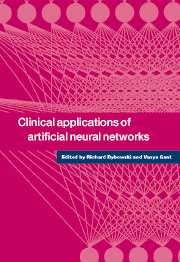Book contents
- Frontmatter
- Contents
- List of contributors
- 1 Introduction
- Part I Applications
- Part II Prospects
- Part III Theory
- 11 Neural networks as statistical methods in survival analysis
- 12 A review of techniques for extracting rules from trained artificial neural networks
- 13 Confidence intervals and prediction intervals for feedforward neural networks
- Part IV Ethics and clinical prospects
- Index
12 - A review of techniques for extracting rules from trained artificial neural networks
Published online by Cambridge University Press: 06 October 2009
- Frontmatter
- Contents
- List of contributors
- 1 Introduction
- Part I Applications
- Part II Prospects
- Part III Theory
- 11 Neural networks as statistical methods in survival analysis
- 12 A review of techniques for extracting rules from trained artificial neural networks
- 13 Confidence intervals and prediction intervals for feedforward neural networks
- Part IV Ethics and clinical prospects
- Index
Summary
Introduction
Even a quick glance through the literature reveals that artificial neural networks (ANNs) have been applied across a broad spectrum of biomedical problem domains. ANNs have been used to aid in the diagnosis of cervical cancer (Mehdi et al. 1994; Mango et al. 1994) and breast cancer (Downes 1994; Feltham & Xing 1994). ANNs have also been applied to prediction tasks including the likelihood of onset of myocardial infarction (Browner 1992) and the survival rates of cancer sufferers (Burke 1994). Other application areas include interpretation of medical images (Lo et al. 1994; Silverman & Noetzel 1990), the interpretation of electrocardiograph data (Kennedy et al. 1991) and biochemical analysis. ANN architectures used in these studies include feedforward multilayer networks trained by backpropagation, recurrent networks (Blumenfeld 1990), self-organizing maps (Dorffner et al. 1993), neurofuzzy systems (Tan & Carpenter 1993) and hybrid systems (Pattichis et al. 1994).
The ANN approach has been demonstrated to have several benefits including the following:
ANNs can be trained by examples drawn from the problem domain rather than rules laboriously drawn from human experts.
ANNs are tolerant of ‘noise’ in the input data.
ANNs can, with a high degree of accuracy, ‘generalize’ over a set of unseen examples.
The use of a trained ANN eliminates issues associated with human fatigue and habituation (Eisner 1990; Boon & Kok 1993).
The use of an automated approach allows analysis of conditions and diagnosis in real time.
- Type
- Chapter
- Information
- Clinical Applications of Artificial Neural Networks , pp. 256 - 297Publisher: Cambridge University PressPrint publication year: 2001
- 3
- Cited by



